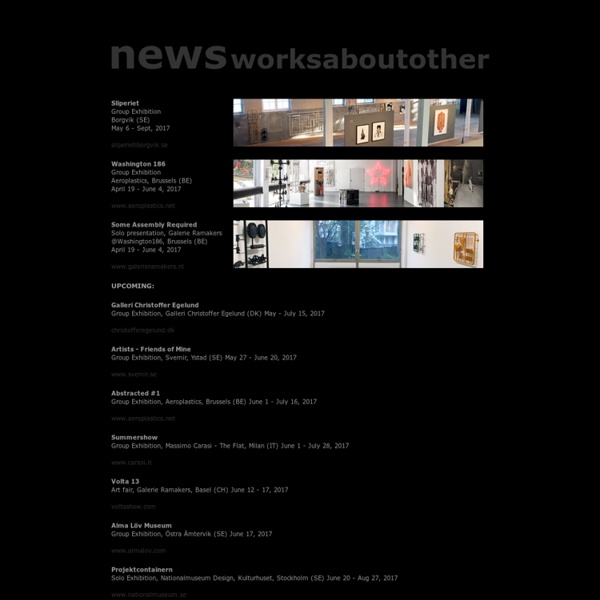



RON van der ENDE 4 Art Lessons from Bauhaus Master Josef Albers Though he demanded focus, Albers also wanted his students to be absorbed by mundane visual phenomena, whether that be the flash of light when a television turns off, or the movement of color when a tea bag enters hot water. According to Albers, artists needed to have open eyes, sensitive to the lines, forms, and hues that are often overlooked. Drawing the shapes (or “negative spaces”) between objects—whether that be chair legs, milk bottles, or plant leaves—would help students develop this sense of heightened perception. For Albers, art lessons always doubled as life lessons, and he believed that students who cultivated “visual empathy” would also develop social empathy. In so doing, Albers wanted to rid art and society from hierarchy. Embodying these lessons, as you might imagine, takes time.
樹脂作品 - 金魚養画場 - 美術作家 深堀隆介 オフィシャルサイト 金魚養画場 美術作家 深堀隆介オフィシャルサイト 金魚養画場 > 樹脂作品 樹脂作品 ホーム | お知らせ | 金魚観 | 経歴 | お問い合わせCopyright © Riusuke Fukahori. the Solomon R. Guggenheim Museum : Free Texts : Download & Streaming "Exhibition 72/6."--Colophon Topic: Art, European Source: folio Catalog of an exhibition held at the Museo de Bellas Artes de Bilbao, May 10-July 15, 1995 Topic: Solomon R. Guggenheim Foundation Topics: Guggenheim, Peggy, 1898-1979, Peggy Guggenheim Collections, Painting, Modern, Painting Catalog of an exhibition held at the Solomon R. the Solomon R. by Iglesias, Cristina, 1956-; Giménez, Carmen; Solomon R. Catalog of an exhibition held at Solomon R. "Mostra ... Cover title: The Guggenheim Museum collection, 1900-1980 Topics: Solomon R. Catalog of an exhibition held at the Solomon R. 72 p. Catalog of an exhibition held at the Guggenheim Museum Soho, NY, Nov. 20, 1996-Jan. 19, 1997 Topics: Cai, Guoqiang, 1957-, Hugo Boss Prize, Art, Modern Catalog of an exhibition held at the Peggy Guggenheim Collection, March 6-April 14, 1986 Topic: Hélion, Jean, 1904-1987 Catalog related to an exhibition held at the Solomon R. Includes bibliographical references and index Topics: Solomon R.
Japanese-ness in Japanese Contemporary Art: ‘Roppongi Crossing: Future Beats in Japanese Contemporary Culture’ 日本当代艺术中的日本性:“六本木岔口:未来的脉动” | We need money not art Vicente Gutierrez走访了在东京六本木山森美术馆举办的一个艺术展,并为我们发回了报道: 作为2004年展览的延续,“六本木岔口”的四位策展人选出了代表日本新兴创意的36位艺术家。这些艺术家的作品与日本艺术形成时期(既1960年代和1970年代)最具有影响力的日本艺术家的作品并排放置。 策展人们将这些汇集成展览,也引发了这样的疑问:是什么让这些艺术家走到一起的? 截至1月14日,一些选择该展览的作品 佐藤雅彦+桐山孝司(Sato Masahiko+Kiriyama Takashi):算术公园2007。 佐藤雅彦和桐山孝司在一个交互式装置中采用了RFID技术,游戏的参与者选择一张写有数字的卡片挂在脖子上,本质上他们就成了这些数字。 榎忠(Enoki Chu),RPM-1200,2005。 榎忠的RPM-1200[2005]是一个未来主义的都市景观设计,其特点是以(碎屑)金属为材料进行的高度精细的手工制作。 岩崎贵宏(Iwasaki Takahiro),模型倒影,2001。 岩崎贵宏精雕细琢复制出的京都的金阁寺(和它的倒影,为了表达折射的效果而略有偏移)则体现了本次展览传统的一面。 右图:鬼头健吾,皇家,2007。 定名为“皇家”,鬼头多彩而富于生机的视觉多面体同小型螺旋桨叶安置在一起,并且即使嗡嗡作响,但该作品对视觉的吸引依然胜过其对听觉的吸引。 山口崇司(Yamaguchi Takashi) 基于算法的交互式模型带领我们进入一个全新的环境,在这里我们怀疑我们的行为和认知带给(可视化)数据的影响。 山口崇司,d.v.d “六本木岔口”展强调了策展人为日本“艺术”所打的标签,并且,作为一次全面审视日本艺术的展出,36位艺术家的组合看起来更可能导致分化而非完整的景象。 图片均为森美术馆所有。 原文OriginalText 责编:sophywt
Maria Lai. Tenendo per mano il sole | MAXXI 19 June 2019 - 12 January 2020 opening hours TUESDAY 11:00 am – 8:00 pmWEDNESDAY 11:00 am – 7:00 pmTHURSDAY 11:00 am – 7:00 pmFRIDAY 11:00 am – 8:00 pmSATURDAY 11:00 am – 8:00 pmSUNDAY 11:00 am – 7:00 pmThe ticket office is open until 1 hour before Museum closing. CLOSING DAYS Every Monday, 1 May, 25 December Palombini at MAXXI Cafe MONDAY chiusoTUESDAY 8:00 am – 8:00 pmWEDNESDAY 8:00 am – 7:30 pmTHURSDAY 8:00 am – 7:30 pmFRIDAY 8:00 am – 8:00 pmSATURDAY 10:00 am – 8:00 pmSUNDAY 10:00 am – 7:30 pm Mediterraneo restaurant and garden MONDAY chiusoTUESDAY 11:00 am – 00:00 amWEDNESDAY 11:00 am – 00:00 amTHURSDAY 11:00 am – 00:00 amFRIDAY 11:00 am – 02:00 amSATURDAY 11:00 am – 02:00 amSUNDAY 11:00 am – 00:00 am Via Guido Reni, 4/A via Guido Reni, 8 (during bookshop and cafe’s opening hours) 00196 Roma The library will be closed from Wednesday 23 October to Friday 8 November for energy efficiency works. Opening hours & tickets Buy ticket onlineRemind meScarica la mini-guida
Conceptual Art « Alphabet Phill Niblock After an early period studying economics (BA, Indiana University, 1956) Niblock came to New York in 1958. Initially he worked as a photographer and filmmaker. Much of this activity centered around photographing and filming jazz musicians. Thereafter he made a number of films in a series titled The Movement of People Working. These films are remarkable for their realistic quality and absence of artifice, their use of long takes in high resolution and their supposedly artless juxtaposition of compelling images in vivid colors. Niblock’s first musical compositions date from 1968. Niblock’s music is an exploration of sound textures created by multiple tones in very dense, often atonal tunings (generally microtonal in conception) performed in long durations. Niblock’s compositional process often begins with recordings of single, absolute tones played by a specific musician with the breathing and attack edited out.
Overlooked No More: Claude Cahun, Whose Photographs Explored Gender and Sexuality The photographs are by far her most compelling work. At first, scholars thought of them as self-portraits. But the gathering consensus is that Cahun choreographed and posed for the photos, and that her romantic partner, Marcel Moore, who was born Suzanne Malherbe, often pressed the button. It was a collaboration. Cahun died on Dec. 8, 1954, at age 60, on the tiny Channel Island of Jersey off the Normandy coast of France. In the 1990s, however, she received a rush of attention as gender issues were gathering steam around the world. A French writer, François Leperlier, published a book on Cahun and helped organize the first exhibition of her work, at a museum in Paris. Professors and graduate students in art history and in feminist and gender studies began writing about her. Cahun’s photographs have been displayed in group shows in the last two years in nearly a dozen museums in London, Paris, Washington, Melbourne, Warsaw and elsewhere.
**This combination of the now-familiar and the new-unknown are among the various factors that come together to create the irresistible pull of these objects. This re-iterated fascination and the overwhelming desire that follows is central to my art practice. (m. johansson) by agnesdelmotte Jul 18